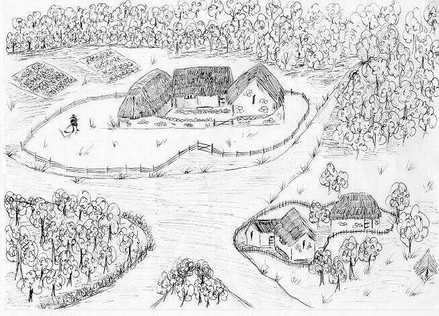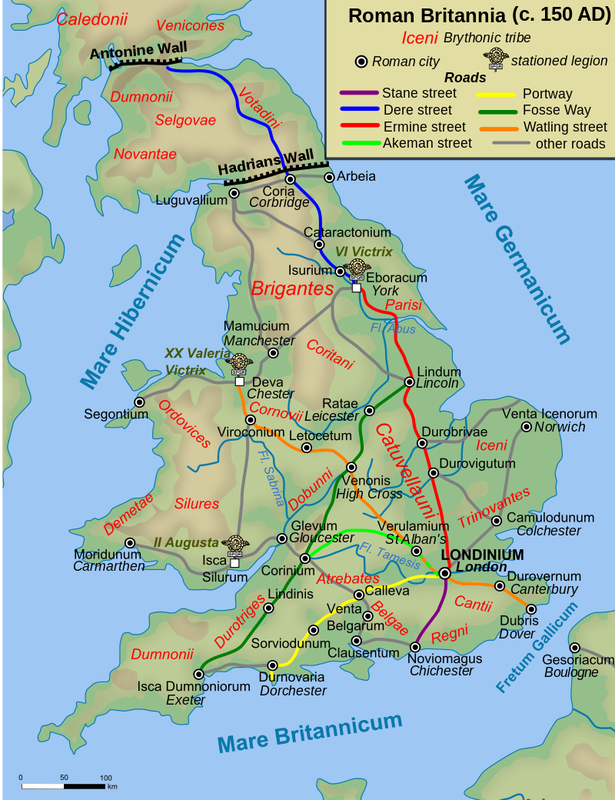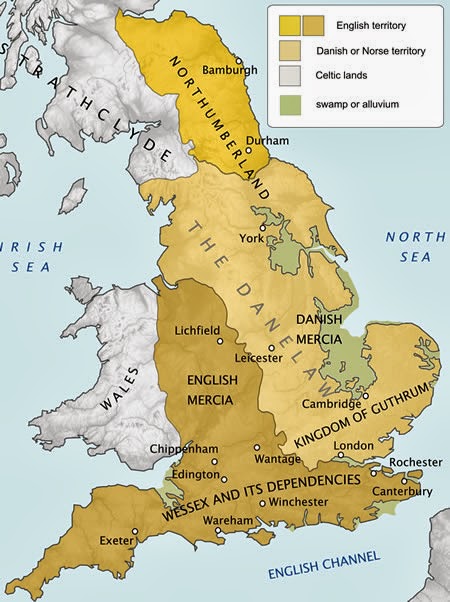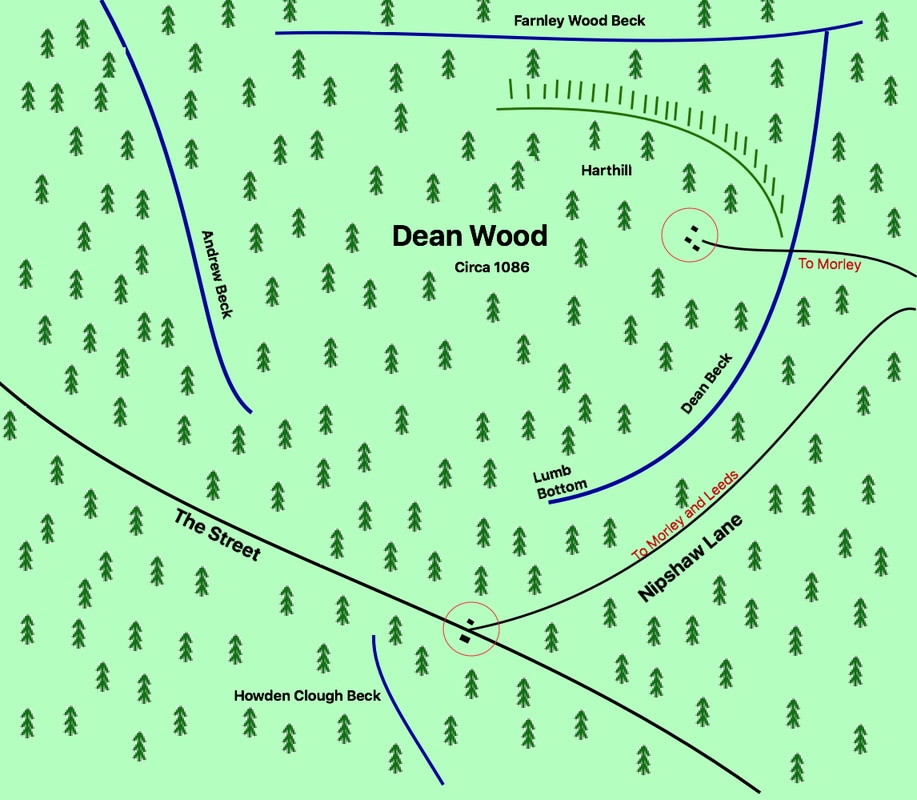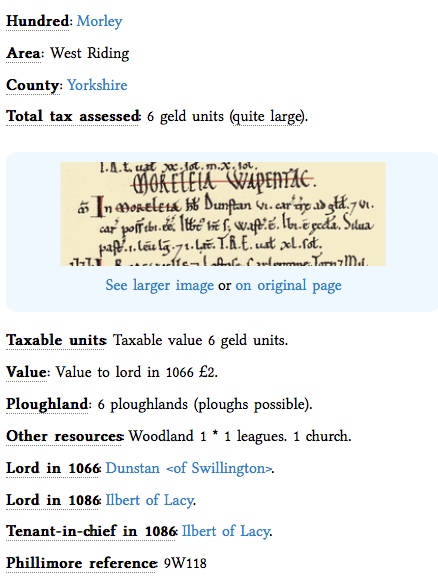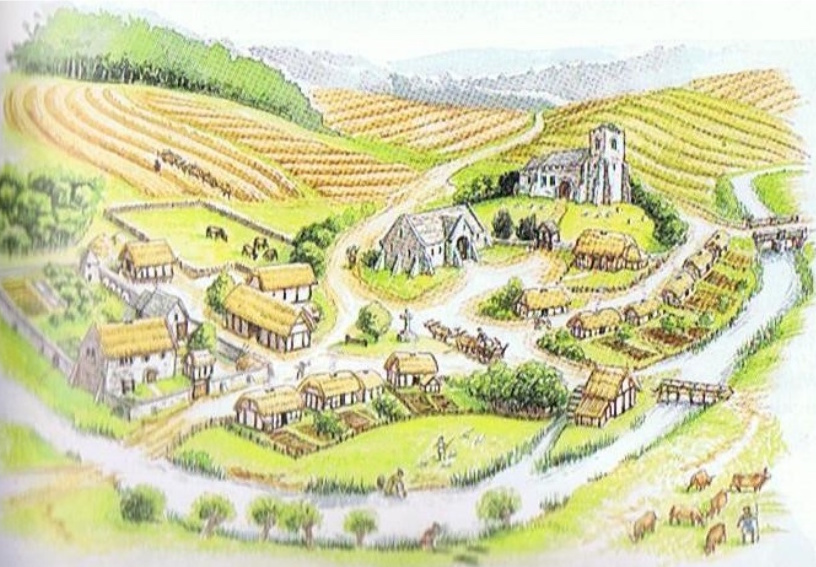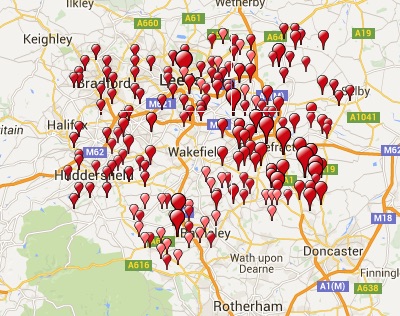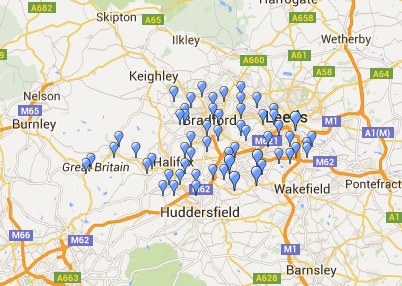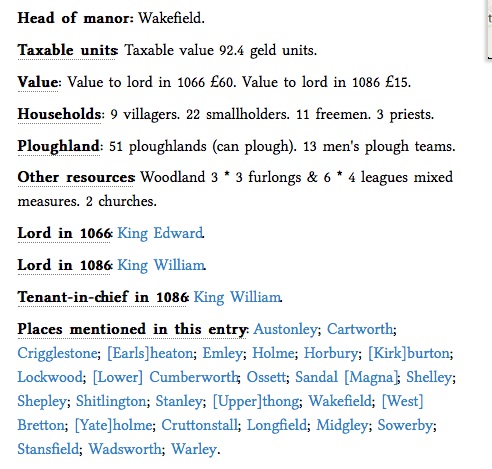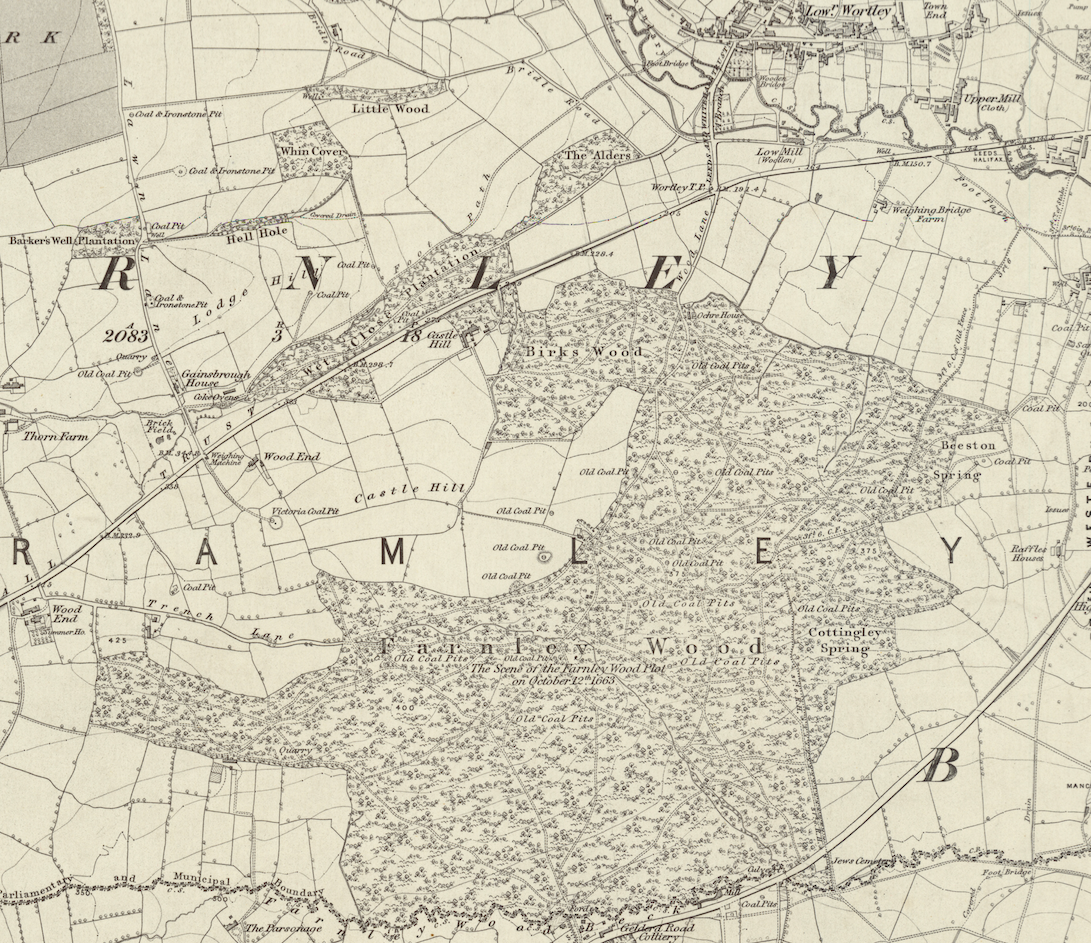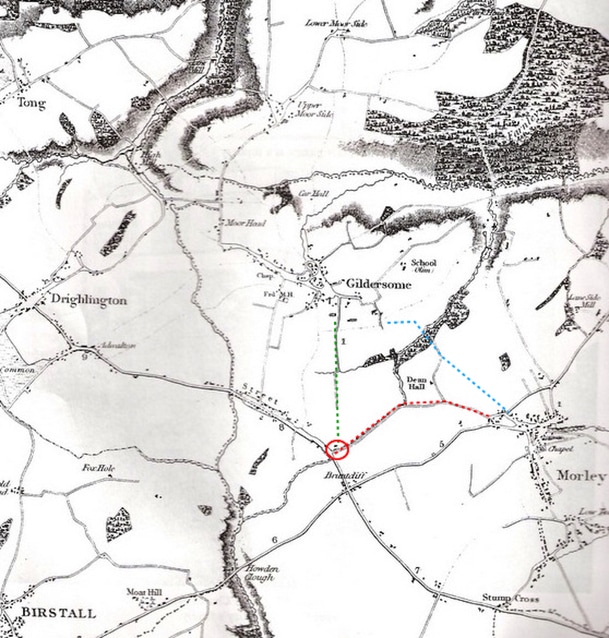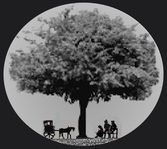
Use pull down menus
above to navigate the site.
above to navigate the site.
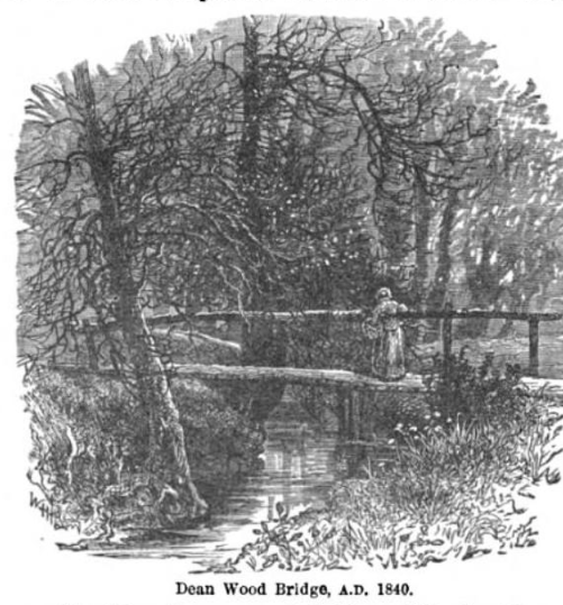
Dean Wood
As previously mentioned, the name Dean Wood is used to describe the area now known as the district of Gildersome as it was in 1066. That is all the land within the boundaries of Dean Beck, Farnley Beck, Andrew Beck and the headspring of Howden Clough, with Hart Hill being its most prominent feature. In 1066, it was a thick woodland, mostly untouched. We know this because of a 13th century text that mentions the "assart of Gildus", and specifically pinpoints it just south of Farnley Wood Beck. Philip Henry Booth in his History of Gildersome wrote: "In the Coucher Book of Nostell Priory, according to Sheard, the boundaries of the parishes of “Batelay” and Leeds are described as “a certain river descending between the wood of Farnley and the assart of Gilders as far as the hospital of Beeston.” The hospital of Beeston was founded in 1322, and as the word “assart” means land cleared of wood, we may take it that in the 14th century there was land cultivated in Gildersome. Sheard’s rendering of the entry is a little different from Scatcherd’s."
William Smith, in his book, 'Morley Ancient and Modern', wrote the following about what has remained of Dean Wood:"In the field beyond the site of Holliday's pit is the pathway leading to Gildersome through Dean Wood, the last-named being of considerable extent, and would doubtless at the time of the Conquest include the smaller copses known as Daffield Wood, Clubbed Oakes, and Clark Springs, which extended east and west down to Beeston. The name Dean or Den is a very common one. BARDSLEY says that " a den was a sunken and wooded vale, where cattle might find alike cover and pasture." In this way den came to be spoken of in connection with animal life ; and we find the ram in Ramsden, the swine in Swinden, the wolf in Wolfenden, and the hog in Ogden. At one time, Morley would possess, in common with many other Yorkshire villages, that important public official known as the " swine-ringer." These men did not ring the pigs themselves, but the prerogative of the office was to see that no pig was allowed upon the common without one strong nail, at least, being firmly embedded in its nose. In those days there were no hedges, making separate enclosures of fields, but plenty of woods. Every foot of ground was not then marked out and held by individual freeholders. There was a common-right ; that is to say, every native householder had free range for his horse, or cow, or pig. The name "Dean" has many other significations, as Den (A.S.) a forest or outlying pasture in the woods; Den (Celtic) a small valley or dingle. Names of places ending in den (neuter) always denoted pasture, usually for swine. Another authority says that " the term dene or dean in its local acceptation indicates a narrow wooded valley, whose Tradition has connected Dean Wood with a ferocious sow, the terror of many youngsters, more than fifty years ago, who durst never go through the wood alone for fear of the " Dean Sow," as it was called. The styes, which were placed in unsavoury proximity to most of the cottages in Morley, were only used as sleeping places for the swine, which were driven to and fro, to Dean and other woods, by the Seniors or swineherds of former generations, and in later times by happy youngsters, who whiled away their time in bird-nesting or nutting."
As previously mentioned, the name Dean Wood is used to describe the area now known as the district of Gildersome as it was in 1066. That is all the land within the boundaries of Dean Beck, Farnley Beck, Andrew Beck and the headspring of Howden Clough, with Hart Hill being its most prominent feature. In 1066, it was a thick woodland, mostly untouched. We know this because of a 13th century text that mentions the "assart of Gildus", and specifically pinpoints it just south of Farnley Wood Beck. Philip Henry Booth in his History of Gildersome wrote: "In the Coucher Book of Nostell Priory, according to Sheard, the boundaries of the parishes of “Batelay” and Leeds are described as “a certain river descending between the wood of Farnley and the assart of Gilders as far as the hospital of Beeston.” The hospital of Beeston was founded in 1322, and as the word “assart” means land cleared of wood, we may take it that in the 14th century there was land cultivated in Gildersome. Sheard’s rendering of the entry is a little different from Scatcherd’s."
William Smith, in his book, 'Morley Ancient and Modern', wrote the following about what has remained of Dean Wood:"In the field beyond the site of Holliday's pit is the pathway leading to Gildersome through Dean Wood, the last-named being of considerable extent, and would doubtless at the time of the Conquest include the smaller copses known as Daffield Wood, Clubbed Oakes, and Clark Springs, which extended east and west down to Beeston. The name Dean or Den is a very common one. BARDSLEY says that " a den was a sunken and wooded vale, where cattle might find alike cover and pasture." In this way den came to be spoken of in connection with animal life ; and we find the ram in Ramsden, the swine in Swinden, the wolf in Wolfenden, and the hog in Ogden. At one time, Morley would possess, in common with many other Yorkshire villages, that important public official known as the " swine-ringer." These men did not ring the pigs themselves, but the prerogative of the office was to see that no pig was allowed upon the common without one strong nail, at least, being firmly embedded in its nose. In those days there were no hedges, making separate enclosures of fields, but plenty of woods. Every foot of ground was not then marked out and held by individual freeholders. There was a common-right ; that is to say, every native householder had free range for his horse, or cow, or pig. The name "Dean" has many other significations, as Den (A.S.) a forest or outlying pasture in the woods; Den (Celtic) a small valley or dingle. Names of places ending in den (neuter) always denoted pasture, usually for swine. Another authority says that " the term dene or dean in its local acceptation indicates a narrow wooded valley, whose Tradition has connected Dean Wood with a ferocious sow, the terror of many youngsters, more than fifty years ago, who durst never go through the wood alone for fear of the " Dean Sow," as it was called. The styes, which were placed in unsavoury proximity to most of the cottages in Morley, were only used as sleeping places for the swine, which were driven to and fro, to Dean and other woods, by the Seniors or swineherds of former generations, and in later times by happy youngsters, who whiled away their time in bird-nesting or nutting."
|
Right is an 1822 map of Gildersome and its surrounding region before Gelderd Road. Dean Wood's extent in 1822 seems to be similar to what remains today. In 1066 it was part of a forest that covered the map.
The red dashed line depicts "Neepshaw" Lane, now called Nepshaw Lane. The blue line is an ancient route from Gildersome to Morley through Dean Wood, using the footpath bridge shown above. The green line is another old entrance into Gildersome begining at the intersection of Nepshaw Ln. and the Street (Red circle). The road to Bruntcliffe and then through Howden Clough didn't exist in the early middle ages. |
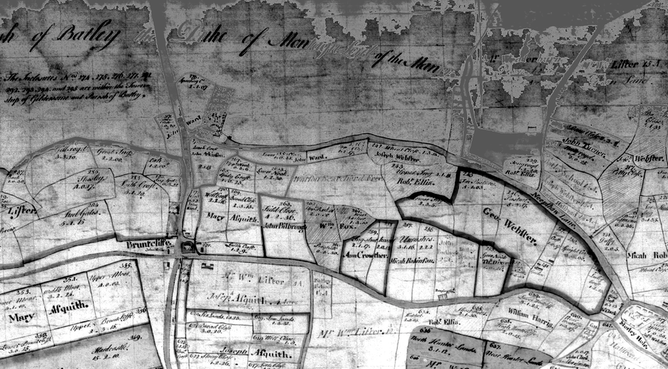 Neepshaw Ln and Bruntcliffe Ln from Lord Dartmoth's map of Morley, circa 1780. Click to Expand.
Neepshaw Ln and Bruntcliffe Ln from Lord Dartmoth's map of Morley, circa 1780. Click to Expand.
"Neepshaw" Lane
If the quote "Location, Location, Location" applies to prime real estate, it would then apply to Dean Wood, which encompassed the intersection of the Street and the Leeds to Manchester Road. So it was that from Dean Wood one could have direct access to the main roads leading to Leeds, Halifax, Manchester, Bradford and Wakefield, as well as all towns and villages in between. Today, that intersection can be found where Nepshaw Lane joins with the Street. Back then, Nepshaw Lane had significance as a section of the main road from the Street to Leeds via Morley Hole. This was centuries before the road through the Spen Valley, via Bruntcliffe, took over as the main thoroughfare. Though shorter, the Bruntcliffe route was much steeper, back in the days of oxcarts and dirt roads, this made a big difference, especially when muddy. This makes sense if one considers that the gradient of Nepshaw Lane, between Morley Hole and the Street, was a difference in elevation of 90 feet, compared to Bruntcliffe Lane which was 140 feet. After the turnpike system came to the area, circa 1730s, and wagon and road technology improved, the Bruntcliffe route stole Nipshaw's traffic. Nepshaw Lane continued to be used as an alternative to Bruntcliffe but its traffic continued to diminish until the late 19th century severed it in two and condemned it to obscurity as an insignificant country lane.
Norrison Scatcherd, in his 1823 'History of Morley' said this about Neepshaw Lane: "I would just state that the road from Leeds to Manchester in these times, was as follows : — First, through Beeston to " Morley Hole." and up Neepshaw-lane to the "' Street," or Roman road (extending from about Bradford to Castleford, as hereafter will be mentioned) ; next, along this road, till it reached Adwalton. It then was left, and the way was over Adwalton-moor, down " Warren's-lane," past "Oakwell," and up to Gomersal. This also, was one of the ways, perhaps the only one, to Halifax."
Whether the Street was a Roman road or not is still open to debate, however, there's no doubt that the roads in 1066 were ancient and little better than a set of parallel ruts. Taking goods to far off markets could be laborious work made worse in bad weather. From Dean Wood, the best markets were found at Leeds, 5 miles away, and Wakefield, 8 miles off, as both had access to river trade. In the middle ages transporting merchandise to these towns could take all day, if not longer. And, dangerous as well. Dean Wood and Farnley Wood beyond, must have been a perfect location from which marauders could pounce upon unsuspecting travelers, then disappear quickly back into the forest.
Next: Medieval Gildersome
If the quote "Location, Location, Location" applies to prime real estate, it would then apply to Dean Wood, which encompassed the intersection of the Street and the Leeds to Manchester Road. So it was that from Dean Wood one could have direct access to the main roads leading to Leeds, Halifax, Manchester, Bradford and Wakefield, as well as all towns and villages in between. Today, that intersection can be found where Nepshaw Lane joins with the Street. Back then, Nepshaw Lane had significance as a section of the main road from the Street to Leeds via Morley Hole. This was centuries before the road through the Spen Valley, via Bruntcliffe, took over as the main thoroughfare. Though shorter, the Bruntcliffe route was much steeper, back in the days of oxcarts and dirt roads, this made a big difference, especially when muddy. This makes sense if one considers that the gradient of Nepshaw Lane, between Morley Hole and the Street, was a difference in elevation of 90 feet, compared to Bruntcliffe Lane which was 140 feet. After the turnpike system came to the area, circa 1730s, and wagon and road technology improved, the Bruntcliffe route stole Nipshaw's traffic. Nepshaw Lane continued to be used as an alternative to Bruntcliffe but its traffic continued to diminish until the late 19th century severed it in two and condemned it to obscurity as an insignificant country lane.
Norrison Scatcherd, in his 1823 'History of Morley' said this about Neepshaw Lane: "I would just state that the road from Leeds to Manchester in these times, was as follows : — First, through Beeston to " Morley Hole." and up Neepshaw-lane to the "' Street," or Roman road (extending from about Bradford to Castleford, as hereafter will be mentioned) ; next, along this road, till it reached Adwalton. It then was left, and the way was over Adwalton-moor, down " Warren's-lane," past "Oakwell," and up to Gomersal. This also, was one of the ways, perhaps the only one, to Halifax."
Whether the Street was a Roman road or not is still open to debate, however, there's no doubt that the roads in 1066 were ancient and little better than a set of parallel ruts. Taking goods to far off markets could be laborious work made worse in bad weather. From Dean Wood, the best markets were found at Leeds, 5 miles away, and Wakefield, 8 miles off, as both had access to river trade. In the middle ages transporting merchandise to these towns could take all day, if not longer. And, dangerous as well. Dean Wood and Farnley Wood beyond, must have been a perfect location from which marauders could pounce upon unsuspecting travelers, then disappear quickly back into the forest.
Next: Medieval Gildersome
